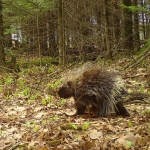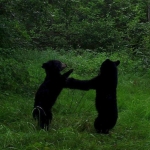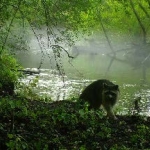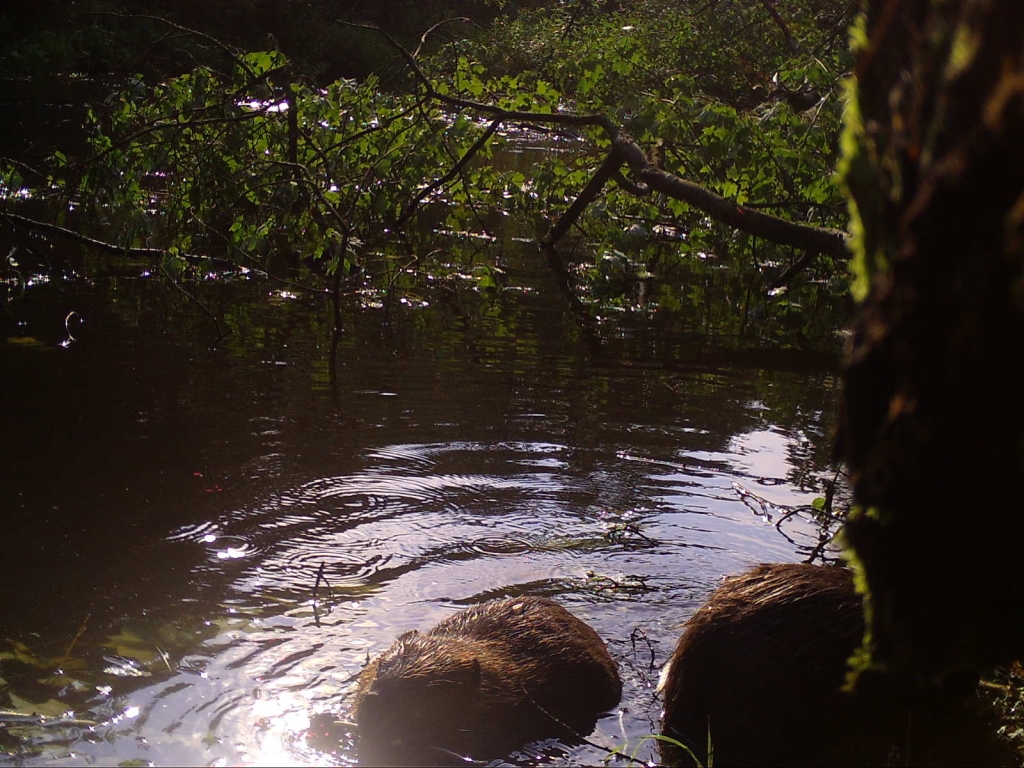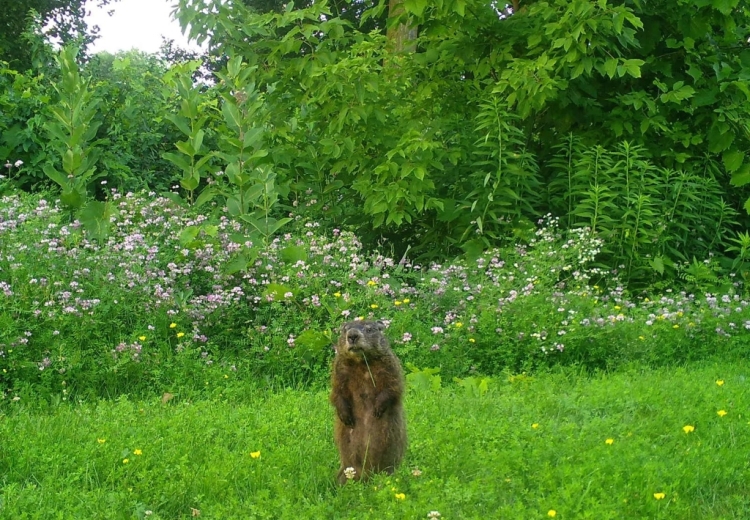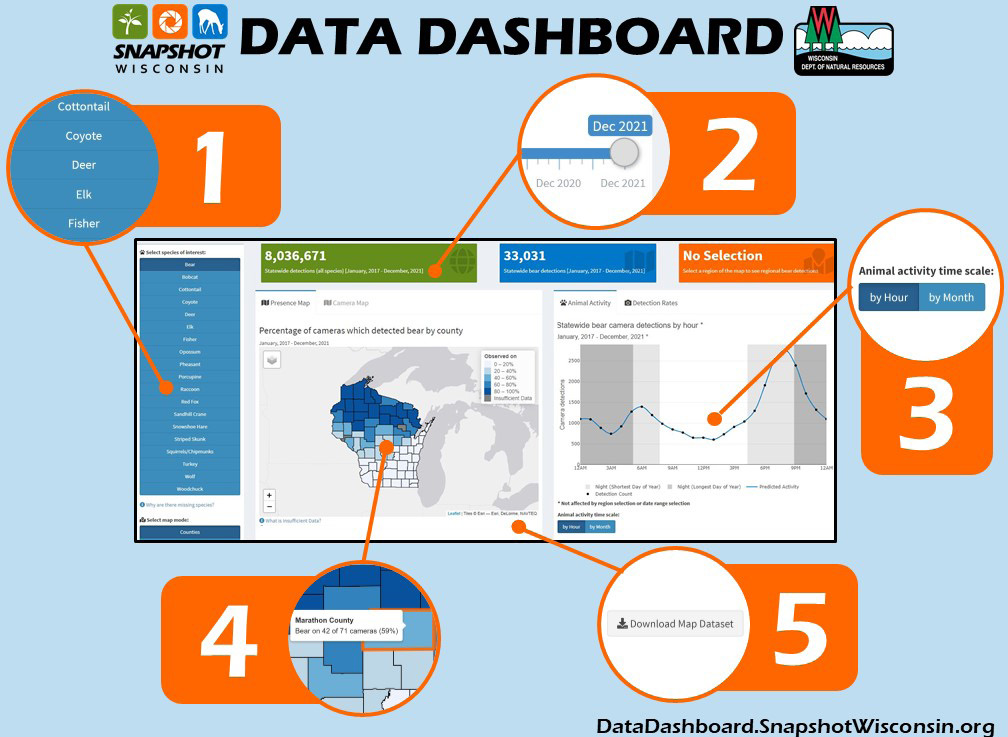Snapshot Wisconsin June 2022
Snapshot Wisconsin’s volunteers are passionate about wildlife monitoring and natural resources management, so it’s no wonder they want to share that excitement with the world. However, that excitement is sometimes lost on others, so the Snapshot team asked two of our educators for advice on getting others excited about natural resources and the Snapshot Wisconsin program.
The team also shares their favorite volunteer science programs from across the country for any volunteers who want to get even more involved. Lastly, the team has an exciting announcement about the Data Dashboard. Read all about it in this edition of the Snapshot Wisconsin Newsletter.
Sharing Our Excitement About Nature
Two of Snapshot's educators advise on how to get your friends and family excited about nature and wildlife monitoring.
Expanding Citizen Science Horizons
The Snapshot team highlights volunteer science programs from across the country for anyone interested in doing more citizen science.
The 2021 Data Is Available On The Data Dashboard
The Snapshot team added another year's worth of data to the Data Dashboard. Check out what you can learn on the dashboard and explore the data yourself!
Sharing Our Excitement About Nature
We’ve all felt disappointed when we share something we are excited about with a friend or family member, and they don’t find it as exciting as we do. And it’s ok that they don’t find the same level of excitement, but does that mean it isn’t worth trying to involve them?
Of course not! Today, let’s hear from two Snapshot educators about ways they’ve found success in getting others excited about Wisconsin’s wildlife and nature. These educators shared their stories and advised on what has worked for them.
Engagement In The Classroom
Tim Sprain, a 7th-grade teacher in La Crosse, Wisconsin, teaches several subjects (reading, writing, social studies and science) and serves as the science coordinator for the entire School District of La Crosse for grades 6-12. Sprain has a special love for nature and has been using Snapshot Wisconsin in his curriculum for several years.
At the beginning of each year, Sprain has his students complete a survey asking if they describe themselves as “nature people”. Normally, only about 5% of the students describe themselves this way, but that number has quickly risen to 25% in recent years. Sprain was excited to see a rise in his students' appreciation of outdoor spaces because many of his students aren’t regularly exposed to nature, nor do they have a passion for Wisconsin’s wildlife.
Sprain monitors three Snapshot trail cameras in three separate counties and uses the photos as a hook for his class. His favorite photos are of rarer species that many students have never seen (like a fisher). “A lot of these animals live only in people’s imaginations,” Sprain said.
In one of the latest batches of photos, the kids were enamored with a family of beavers caught on the trail camera. “A tree had fallen right in front of the camera into the creek. In just over four weeks, the beavers totally dismantled all the branches off this tree,” Sprain said. The photos even captured the beavers grooming each other. “The kids were all in.”
A different photo captured a view of a bobcat with its latest prey. Sprain said that the photo also gripped the students’ attention. “We’ll see shots where suddenly a bobcat walks through with a cottontail in its mouth. Those are high drama pictures that kids absolutely love,” Sprain said.
Sprain enjoys seeing the excitement in his students' eyes when they discover a high-drama picture. It creates a cool memory between the students and Sprain, one they remember for years.
The experiences in Sprain’s classroom are particularly powerful for students unfamiliar with nature. Sprain said, “We have evidence that kids who never have these [types of] experiences or any interest in nature will gain an interest through Snapshot.” After participating in Snapshot, Sprain said some students ask how else they can get involved in nature. Students have since pursued getting a trapper’s license, going fishing or even going hiking across the beautiful driftless area.
The students' excitement can spill over to their parents too. “Parents ask about the program and what we do [in class]. Snapshot Wisconsin often comes up as one of those things, and I have parents ask how [they can] get involved,” Sprain said. Once the parents get involved, it becomes a family activity.
Sprain likes to see this type of family engagement because he thinks it is important for our future. Sprain said, “I really want future generations to have a great place to live, and Wisconsin is one of the greatest places to live!” Interacting with nature is a great way for youth to learn about Wisconsin’s beauty.
Sprain's Advice
Sprain had advice for people who want to get their friends and family excited about nature. Sprain suggested that people consider how their friends' interests connect to nature and the environment. “What is it that they love to do? Try asking them about their passions and discuss the environmental side of that,” Sprain said.
If they enjoy the conversation, invite them to recreate with you. Whether through classifying photos together or whatever other ways you engage with nature, we encourage you to use your passion and share it with others. Like how Sprain’s students got their parents interested/involved, you can introduce nature into your friends’ and family’s lives. Plus, recreating together builds upon any type of relationship – a parent and child, between siblings or even among friends. The key is to do it together.
If you use Snapshot Wisconsin, don’t forget that there is a larger community you can also engage with. Sprain reiterated, “Snapshot Wisconsin is about building a community of people who are all interested in science and nature. It really feels great to meet new people and see that others are equally excited... Actually, thousands of people are excited with you!”
Sprain has done a great job connecting his students to the natural world around them, and we are thrilled he used Snapshot to do it. Sprain hopes he sparked an initial interest in nature within his students and is eager to see how it grows in the coming years.
Engagement At A Nature Center
We also sat down with a second educator, although she was a different type of educator. Annie McDonnell, now a member of the Snapshot Wisconsin team, similarly has a wealth of experience in engaging new audiences with nature. Before joining the Snapshot team, McDonnell worked at the North Lakeland Discovery Center in Manitowish Waters for 4.5 years as the Naturalist, Citizen Science and Volunteer Coordinator. “My role was to engage public audiences from ages pre-K up to retirees in environmental education programs,” McDonnell said.
McDonnell played a central role in the nature center’s involvement in citizen science projects (including Snapshot Wisconsin). She helped find local support for these programs, and the discovery center is still involved in these volunteer science programs to this day.
McDonnell’s role fits in neatly with the mission of the North Lakeland Discovery Center. McDonnell described the mission as “engaging the public and promoting an ethic of care for Wisconsin’s Northwoods by fostering connections between people, community and nature.”
Do It Together!
Why is it critical to engage people with nature? “Getting folks engaged in something is usually the first step to creating that ethic of care,” McDonnell said. Engaging people with nature isn’t always enough to create a passion for the environment, but McDonnell said it is the first step.
Some visitors to the Discovery Center didn’t have much prior experience with the outdoors, nor did they know much about the Northwoods’ ecology. The area around Manitowish Waters is a popular vacation spot, so many visitors weren’t from the region.
McDonnell would walk with visitors around Statehouse Lake and show them the unique aspects of the local ecology. She’d bring up topics important to the area, such as aquatic invasive species monitoring and shoreline rehabilitation.
McDonnell would also allow volunteers to accompany her when she checked her Snapshot Wisconsin trail camera. She used the half-mile walk (down a gorgeous trail) to talk with them about the program and its impact on the area.
In fact, McDonnell recommends that other Snapshot volunteers bring people along to a camera check. She said it shows how easy and enjoyable being a volunteer scientist can be. “Plus, it’s fun to have a purpose when you’re out in the woods,” McDonnell added.
“It’s all about showing them, instead of just talking about it,” McDonnell said. “The experience of checking a camera helps them feel connected to that camera and the local area. Then, when you classify photos with them, they feel engaged and want to do more with nature.”
McDonnell said she would sneak Snapshot images from her trail camera into the educational programming she oversaw. “I included photos of our local weasels in [a class on furbearers] because they’re awesome and helped show the difference between species,” McDonnell said. “Telling long-tailed weasels apart from short-tailed weasels is definitely a challenge, and the Snapshot photos aided in this effort!”
McDonnell also recalled seeing a trickle-down effect after engaging a nearby landowner. “It started with one volunteer monitoring a given lake for aquatic invasive species. Then, it exploded to like 10 – 20 volunteers monitoring that lake just two years later,” McDonnell said. People like feeling that they positively impacted their environment, and monitoring made it easy to feel that way.
McDonnell had a final thought about how to get people excited about nature. McDonnell suggested talking to your friends about their favorite public lands and seeing if volunteers are needed in that area. Powell Marsh, for example, is a beloved natural area in the Northwoods, and it doesn’t have a Snapshot Wisconsin camera yet. Many people cherish this site, so she thinks it is likely someone would be willing to host a camera there. “If it’s a place that someone loves going to already, it isn’t much to ask them [to check a camera]. Hosting a camera could help deepen their connection to the land further since they’d get to see what species are out on the landscape when they aren’t there,” McDonnell said.
It All Starts With A Spark
While we’d love for Snapshot Wisconsin to be the tool people use to get others excited about nature, as Sprain and McDonnell did, our advice is to make the process unique to you and your interests. Use the ways you already interact with nature - just bring your friends and family along. They may find that they enjoy the experience and that the initial spark is lit.
Take your friends and family outside this summer. Show them the local habitat and recreate it in the ways you love. As the summer takes full effect, it’s the perfect time to share meaningful experiences and bond.
The Snapshot team wishes everyone a wonderful summer. Stay tuned for future newsletters and updates on the Snapshot Wisconsin program.
*This article was written by Michael Kamp, a former Snapshot team member, who has since departed from the team to attend a graduate program in environmental conservation. The Snapshot team thanks him for his hard work and wishes him the best in his future endeavors!
The team wanted to share his article with the Snapshot community and use it to encourage our volunteers to recreate with their loved ones this summer.
Expanding Citizen Science Horizons
If you are interested in branching out as a volunteer scientist, there are plenty of other opportunities to explore. The team wanted to highlight some of the other exciting programs that our volunteers and their loved ones may be interested in. After all, volunteer scientists play an important role in more than just wildlife research.
The state of Wisconsin has a long history of volunteer science programs. The DNR has an extensive list of its own volunteer science programs and partner projects, including programs like the Wisconsin Bumble Bee Brigade and the Wisconsin Rare Plant Monitoring Program.
But what about programs outside of Wisconsin? There are plenty of national programs available on a wide variety of topics. You may have read about one program, Snapshot USA, in our last newsletter when we highlighted our collaboration with the program. However, if you are looking for something else to dip your toes in, check out these other programs:
Community Collaborative Rain, Hail And Snow Network (CocoRaHS)
- A community-based volunteer network of weather observers working together to measure and map precipitation (rain, hail and snow) in their local communities.
- CocoRaHS data is used by meteorologists, hydrologists, teachers, engineers and organizations such as the National Weather Service and the USDA.
- Visit the Wisconsin chapter of CocoRaHS.
FrogWatch USA
- Volunteers report the calls of local frogs and toads heard during evenings from February to August, depending on the area and peak breeding season for local species. The data are then loaded into a public database, similar to Snapshot Wisconsin’s Data Dashboard.
- Partnered with the Citizen Science Academy (hosted by the Chicago Botanic Garden) and the National Geographic Society, FrogWatch USA data is used to help develop practical strategies for conserving frog and toad species.
- Visit FrogWatch USA to learn more.
NASA NeMO-Net
- Map Earth’s oceans in this videogame that trains an artificial intelligence for a NASA supercomputer using FluidCam’s 3D images of the seafloor, the first instrument that can see through waves.
- Players identify coral reefs, other shallow marine environments and marine animals using 2D satellite and drone images and 3D reconstructions of underwater environments. Player classifications are used to teach the convolutional neural network (CNN) called NeMO-Net and help scientists better understand and protect coral reefs globally.
- To dive in, visit NASA NeMo-Net.
The Secchi Dip-In
- Operated by the North American Lake Management Society, this program collects water clarity measurements from rivers, lakes and estuaries to track water quality changes across the continent. Over the past 20 years, the database has accumulated more than 41,000 records on over 7,000 individual waterbodies.
- Volunteers are taught how to take water clarity measurements primarily using a Secchi disk unless the water body is a river or stream that would require a turbidity tube or black disk. Data is primarily collected in July, but the program does accept data year-round!
- Visit the Secchi Dip-In project site, then spend a day on the lake.
We certainly appreciate our volunteers at Snapshot Wisconsin, and we know these programs also appreciate their volunteers. Whether you want to expand your citizen science portfolio into finding collection water samples, listening to frog songs or teaching an AI, there are plenty of options. Have fun exploring!
The 2021 Data Is Available On The Data Dashboard
The Snapshot Wisconsin Data Dashboard now displays trail camera data through the end of 2021!
Since the October 2020 launch of the Data Dashboard, Snapshot Wisconsin has reached several important milestones, such as hitting the 50 million photo mark, and the program isn't slowing down. The Snapshot team is excited to announce another important milestone - the release of the 2021 data to the Data Dashboard!
Here are a few great features you can take advantage of when exploring the Data Dashboard:
- View Snapshot Wisconsin data for 19 species of Wisconsin wildlife, such as bobcat, porcupine, snowshoe hare and more!
- Select a date range of Snapshot trail camera data collected between January 2017 through December 2021.
- Examine plots of animal activity on Snapshot trail cameras from the past four years by the hour of the day and month of the year.
- Compare trail camera detections for each species by county or ecological landscape, ranging from the superior coastal plain to the southwest savanna.
- Download Snapshot Wisconsin trail camera data for free.
Visit DataDashboard.SnapshotWisconsin.org to start exploring!

